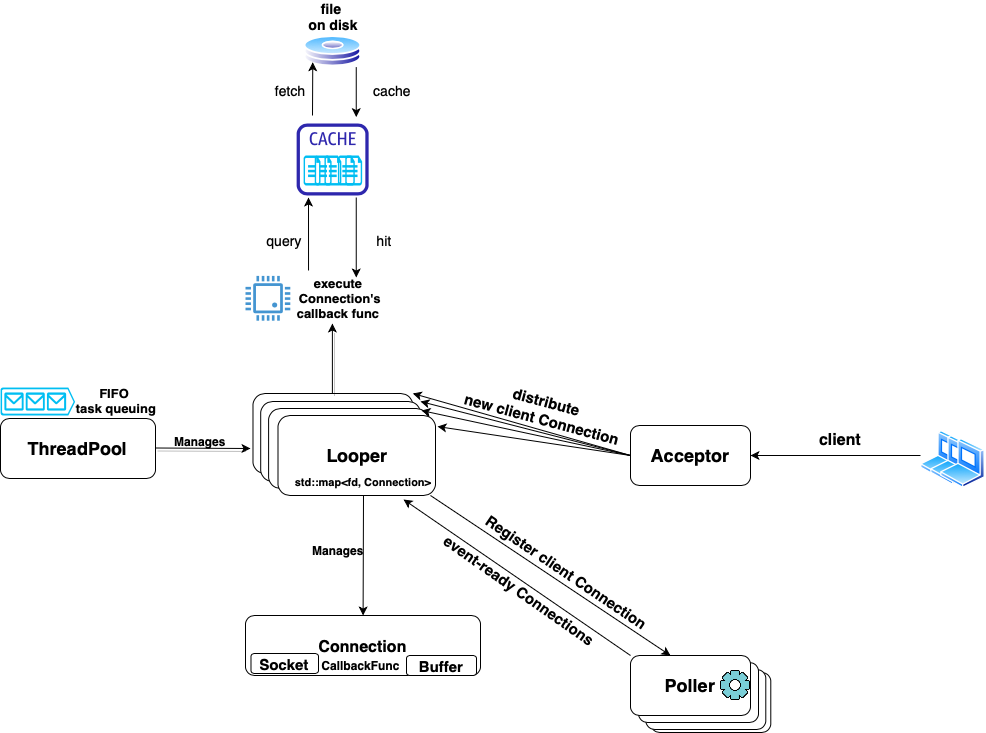Turtle is a C++17-based lightweight network library for web server mainly on Linux. It abstracts the tedious manipulations on the socket into elegant and reusable classes. It allows a fast server side setup where the custom business logic could be specified for each client TCP connection in the form of a callback function. It now supports HTTP GET/HEAD request and response as well.
For any question, feel free to raise issue or pull request or drop me an email here.
- Set non-blocking socket and edge-trigger handling mode to support high concurrency workload.
- Adopt the 'one reactor per thread' philosophy by Shuo Chen with thread pool management.
- Achieve low coupling and high extensible framework.
- Allow users to build custom server by only providing 2 callback functions.
- Support HTTP GET/HEAD request & response.
- Support dynamic CGI request & response.
- Support Caching mechanism.
- Compatible building with MacOS using kqueue.
- Unit test coverage by Catch2 framework.
The above system architecture diagram briefly shows how the Turtle framework works on a high level.
- The basic unit is a Connection which contains a Socket and a Buffer for bytes in-and-out. Users register a callback function for each connection.
- The system starts with an Acceptor, which contains one acceptor connection. It builds connection for each new client, and distribute the workload to one of the Loopers.
- Each Poller is associated with exactly one Looper. It does nothing but epoll, and returns a collection of event-ready connections back to the Looper.
- The Looper is the main brain of the system. It registers new client connection into the Poller, and upon the Poller returns back event-ready connections, it fetches their callback functions and execute them.
- The ThreadPool manages how many Loopers are there in the system to avoid over-subscription.
- Optionally there exists a Cache layer using LRU policy with tunable storage size parameters.
The Turtle core network part is around 1000 lines of code, and the HTTP+CGI module is another 700 lines.
If you are not a Linux system but still want to try out the Turtle on Linux for fun, we provide a Vagrant File to provision the Linux Docker. Notice as of current, Turtle is compatible with Linux and MacOS for build.
-
Install Vagrant and Docker. For macOS, you may use homebrew to install Vagrant but do not use homebrew to install Docker. Instead, download Docker Desktop from the link above.
-
Start the Docker application in the background
-
Drag out the
Vagrantfileand place it in parallel with theTurtleproject folder. For example, consider the following file structure:
/Turtle_Wrapper
- /Turtle
- /Vagrantfile
-
cdto theTurtle_Wrapperfolder and run commandvagrant up --provider=docker. This step should take a few minutes to build up the environment and install all the necessary tool chains. -
Enter the docker environment by
vagrant ssh developer -
cdto the directory/vagrant/Turtle. This directory is in sync with the original./Turtlefolder. You may modify the source code and its effect will be propagated to the docker's folder as well. -
Follow the steps in next section to build up the project.
You may build the project using CMake.
Once you are at the root directory of this project, execute the followings:
// Build
$ mkdir build
$ cd build
$ cmake .. // because CMakeList.txt is in the root directory
$ make
// Format & Style Check & Line Count
$ make format
$ make cpplint
$ make linecountTo test the performance of Turtle server under high concurrency, we adopt Webbench as the stress testing tool.
The source code of the Webbench is stored under the ./webbench directory along with a simple testing shell script.
We fully automated the process so that you can execute the benchmark test in one command:
$ make benchmark
# in Linux the above command will
# 1. build the webbench tool
# 2. run the http server in the background at default 20080 port, serving the dummy index file
# 3. launch the webbench testing with 10500 concurrent clients for 5 seconds
# 4. report back the result to the console
# 5. harvest the background http server process and exitWe performed benchmark testing on an Amazon AWS EC2 instance. The details are as follows:
- Hardware: m5.2xlarge instance on Ubuntu 20.04 LTS with 8 vCPUs, 32 GiB memory, 50 GiB root storage volume. (Be careful that vCPU is not real CPU core, by experiment
std::hardware_concurrency() = 2in this case) - QPS: 62.3k (no cache) | 62.8k (with cache)
The performance improvement from Cache might not seem significant. Partly because disk I/O is getting faster nowadays, the cost of loading a small index.html might be smaller than the mutual exclusive operations in the Cache.
Later on, when database connector comes into play, the indispensability of the Cache layer will be more obvious.
In order to gain a better sense of comparative performance, we benchmarked a few other leading popular C++ network webserver on the Internet with the best configuration to our knowledge in order to be fair.
To reiterate, by no means should we judge different libraries only on benchmark testing of limited scope and possible misconfiguration by the unfamiliar like us. It's solely for the purpose for getting the magnitude right.
All the benchmarks statistics listed below are performed on the same hardware and transferring same dummy index file with 10500 concurrent clients using webbench tool.
- TinyWebServer: best QPS = 38.5k
# we run the TinyWebServer with the configuration of:
# 1. listener fd and connection fd mode: -m 1 LT + ET | -m 3 ET + ET
# 2. 8 threads as on a 8 vCPUs instance
# 3. turn off logging
# 4. -a 0 Proactor | -a 1 Reactor
# 5. compiler optimization level set to -O3
# Proactor LT + ET
$ ./server -m 1 -t 8 -c 1 -a 0
$ QPS is 38.5k
# Proactor ET + ET
$ ./server -m 3 -t 8 -c 1 -a 0
$ QPS is 38.2k
# Reactor LT + ET
$ ./server -m 1 -t 8 -c 1 -a 1
$ QPS is 26.7k
# Reactor ET + ET
$ ./server -m 3 -t 8 -c 1 -a 1
$ QPS is 25.6k- Muduo: best QPS = 48.3k
# We use the 'muduo/net/http/tests/HttpServer_test.cc' as the test program
# set it to run in the benchmark mode with 8 threads in the pool
# with most of the logging disabled- libevent: single-thread best QPS = 29.0k
We use the sample script here for easy testing.
# Notice this testing is running libevent http server with single-thread using I/O multiplexing
# it's already very performant and has not fully utilized the underlying 8-core hardware.
# we might try test it with pthread and work queue under the multi-thread setting
# but it's too much work for now for the benchmark purposeThe classes in the Turtle library are designed with the focus of decoupling firmly in mind. Most of the components can be taken out alone or a few together and used independently, especially those components in the network core module.
Let's take an example from the most basic Socket class, assuming that we just want to borrow the Turtle library to avoid the cumbersome steps of socket establishment. First, let's take a look at the main interface of the Socket class:
/**
* This Socket class abstracts the operations on a socket file descriptor
* It can be used to build client or server
* and is compatible with both Ipv4 and Ipv6
* */
class Socket {
public:
Socket() noexcept;
auto GetFd() const noexcept -> int;
/* client: one step, directly connect */
void Connect(NetAddress &server_address);
/* server: three steps, bind + listen + accept */
void Bind(NetAddress &server_address, bool set_reusable = true);
/* enter listen mode */
void Listen();
/* accept a new client connection request and record its address info */
auto Accept(NetAddress &client_address) -> int;
private:
int fd_{-1};
};With such an interface, we can quickly and easily build client and server sockets in a few lines:
#include "core/net_address.h"
#include "core/socket.h"
// local Ipv4 address at 8080 port
NetAddress local_address("127.0.0.1", 8080, Protocol::Ipv4);
// build a client
Socket client_sock;
client_sock.Connect(local_address);
// build a server
Socket server_sock;
server_sock.Bind(local_address);
server_sock.Listen();
// accept 1 new client connection request
// client_address will be filled with new client's ip info
NetAddress client_address;
int client_fd = server_sock.Accept(client_address);There are many other components in Turtle that are easy to decouple and use separately. You can view the source code and use them according to needs.
To setup a custom server, user should create an instance of TurtleServer and then only needs to provide two callback functions:
- OnAccept(Connection *): A function to do extra business logic when accepting a new client connection.
- OnHandle(Connection *): A function to serve an existing client's request.
Notice that most of common functionality for accepting a new client connection is already implemented and supported in the Acceptor::BaseAcceptCallback, including socket accept, setup and put it under monitor of the Poller.
The function provided in OnAccept(Connection *) by users will be augmented into the base version and called as well. There is no base version for the OnHandle(Connection *). Users must specify one before they can call Begin() on the server.
Let's walk through an example of traditional echo server in less than 20 lines:
#include "core/turtle_server.h"
int main() {
TURTLE_SERVER::NetAddress local_address("0.0.0.0", 20080);
TURTLE_SERVER::TurtleServer echo_server(local_address);
echo_server
.OnHandle([&](TURTLE_SERVER::Connection* client_conn) {
int from_fd = client_conn->GetFd();
auto [read, exit] = client_conn->Recv();
if (exit) {
client_conn->GetLooper()->DeleteConnection(from_fd);
// client_conn ptr is invalid below here, do not touch it again
return;
}
if (read) {
client_conn->WriteToWriteBuffer(client_conn->ReadAsString());
client_conn->Send();
client_conn->ClearReadBuffer();
}
})
.Begin();
return 0;
}The demo of this echo server and client is provided under the ./demo folder for your reference. In the build directory, you can execute the following and try it out.
$ make echo_server
$ make echo_client
// in one terminal
$ ./echo_server
// in another terminal
$ ./echo_clientThe HTTP server demo is under ./src/http folder for reference as well. A simple HTTP server could be set up in less than 50 lines with the help of Turtle core and http module.
The CGI module is built upon HTTP server and executes in the traditional parent-child cross-process way. After parsing the arguments, the Cgier fork a child process to execute the cgi program and communicate back the result to parent process through a shared temporary file.
It assumes the cgi program resides under a /cgi-bin folder and arguments are separated by &. For example, if there is a remote CGI program int add(int a, int b) that adds up two integers. To compute 1+2=3, The HTTP request line should be
GET /cgi-bin/add&1&2 HTTP/1.1This repo is under active development and maintainence. New features and fixes are updated periodically as time and skill permit.
The followings are on the TODO list:
- ✅ Support serving HTTP GET/HEAD Request & Response
- ✅ Revise according to this code review suggestions
- ✅ Refactor the architecture into multiple Reactor mode to improve concurrency
- ✅ Add performance testing benchmark
- ✅ Add a Cache layer to reduce server load and increase responsiveness
- ✅ Enable dynamic CGI request support
- ✅ Support MacOS build compatability by kqueue
- ✅ Complete unit testing coverage
- Benchmark with other leading libraries and profile Turtle's bottleneck
- review suggestions on reddit are listed on issues to contemplate and experiment
- Support timing each client connection and kills inactive ones
- Support Database connection
We also welcome new feature request. We will review them one by one, and priortize its implementation if applicable. Or direct pull request is also welcomed.
Serveral reference books and projects are consulted during the development of Turtle. Much appreciation to those excellent references and helps received.


